The usb c technology charging landscape has changed significantly in the last couple of years for any connected device . Days gone are when waiting hours to boot our devices. Faster charging has become the new standard with USB-C Power Delivery technology being at the forefront of the progress.
But is USB-C necessarily any quicker than the old style of charging? The answer is a resounding yes- and the difference with usb power delivery is bigger than you may imagine.
We are going to cover all the information you need to know about USB-C charging rates for any usb c device that can support fast charging, not only the technology behind it but also the process of selecting an appropriate charger to use with your devices.
What is USB-C Power Delivery?
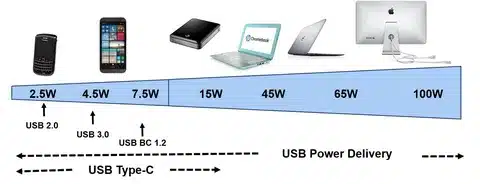
USB-C Power Delivery (PD) is a groundbreaking change in charging speed technology. USB-C PD can provide 15W to a whopping power of 100W, suitable for larger devices as opposed to the conventional charging systems that has a fixed 5 watts of power.
It is fast-charging technology that negotiates the power between the charger and the device. Upon plugging in your device with a proper charging cable, the charger and device communicate to decide on the best power delivery rate.
The result? Your smartphone, tablet or even laptop charge much faster than your traditional methods of charging. USB-C PD is not only an issue of speed, like usb c fast charging, but delivering the correct power in an efficient and safe way.
Above all, USB-C PD is backward compatible. This implies that your older devices will not get damaged in case of using a higher-wattage USB-C PD charger, but will only consume the amount of power they support.
Key Benefits of USB-C Power Delivery
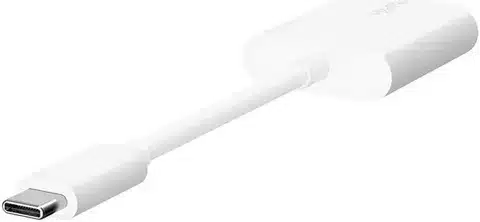
Rapid Charging Speeds
The least subtle benefit of USB-C power delivery is speed. It can require 3-4 hours to charge a modern smartphone up to full capacity using a standard 5W charger. By comparison, a 20W USB-C PD charger can charge the same device to 50, demonstrating how much power it provides, in only half an hour.
The disparity is more dramatic on bigger devices. A laptop could be charged in less than 65 minutes using a 65W USB-C PD charger whereas it could take 2-3 hours when using a conventional laptop charger.
The charging speed is not linear it is exponential. Users report 5070 percent faster charging than the usual methods of charging.
Universal Compatibility
USB-C PD is a universal product, which is one of its most powerful advantages. USB-C PD is cross-brand and cross-unit with usb c connectors unlike proprietary charging standards.
Whether you’re dealing with an iPhone 15, Samsung Galaxy S24, Google Pixel, or MacBook Pro, they can all use the same USB-C PD charger. This allows the elimination of multiple chargers and cable clutter.
The Apple shift to USB-C has more or less resolved the Lightning versus USB-C debate. Even Apple has not been left behind in adopting this standard as it has realized the Apple charging port benefits that USB-C has to offer.
Compact and Travel-Friendly
USB-C PD chargers are much smaller than conventional laptop power adapters. USB-C A 65W USB-C PD charger is equivalent in size to a deck of cards but provides as much power as a heavy laptop brick.
USB-C PD chargers are ideal as travelers have a compact design. You also won’t have to travel with a bunch of chargers specific to each device because a single, high-powered USB-C PD charger will charge everything your smartphone to your laptop.
The savings on weight are significant as well. An older laptop charger will be 1-2 pounds of weight, whereas a similar USB-C PD charger can be less than half a pound of weight.
How USB-C Power Delivery Works
Power Negotiation
USB-C PD is magical in its smart power negotiation system. They can exchange a digital handshake to agree upon the best charging parameters when a device is connected to a USB-C PD charger.
This bargaining occurs on the milliseconds level. The cable quality affects how t device informs the charger its power needs and the charger informs it of what it can deliver. The system thereafter rests on the maximum safe power level.
Such an intelligent communication helps to avoid overcharging and prevent supplying too much power to your device, providing it with its precise amount of power, neither more nor less.
Programmable Power Supply (PPS)
New USB-C PD chargers are programmable and powered by Programmable Power Supply technology. With PPS, the charger can optimally regulate the voltage and current in real-time according to the needs of your device.
The more your battery is filled, the less charging current is applied by PPS in order to avoid overheating and prolong battery duration. This dynamic correction will provide maximum charging during the whole charging cycle.
PPS is useful in smartphones especially where heat can be generated during rapid charging. Power delivery by PPS allows keeping temperatures low and keeping fast-charging rates high.
Safety Features
The most important aspect in USB-C PD design is safety. These chargers have several integrated overcurrent, overvoltage, overheating and short circuit protection.
Temperature control will guarantee that the charger switches off in case it becomes too hot. Current limiting avoids damage in the event of a fault in the charging cable or device.
These security features are automatic and run in background, as you can have peace of mind charging your precious devices.
Devices Compatible with USB-C Power Delivery
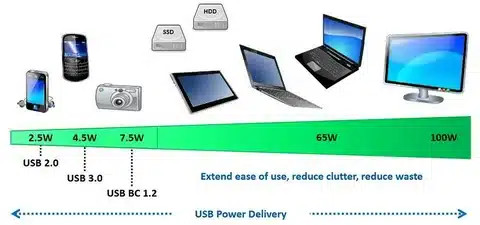
Smartphones
The iPhone 15 and iPhone 16 series were an enormous move in the smart phone industry with the introduction of USB-C compatibility. Its devices are compatible with up to 20W USB-C PD charging, which is much quicker than the former charging on Lightning.
Galaxies S24 and S25 Samsung phones charge at a maximum of 25W USB-C PD. Google Pixel devices are normally 18W to 30W USB-C PD, model dependent.
Fast charging is available in all price ranges, even in low-price smartphones, which are progressively being able to support USB-C PD.
Tablets
The iPad Pro models will charge up to 20W USB-C PD, enabling its large-battery devices to charge faster regardless of power consumption needs.
Tablets in the Samsung Galaxy Tab family have different USB-C PD wattage, but the more premium models allow up to 45W charging to achieve extremely short charge time.
USB-C PD has increased power delivery capacity, which is especially advantageous to the larger batteries found in tablets.
Laptops
USB-C PD has become a widespread way of charging in modern laptops. In models with MacBook Pro, charging is limited to 96W USB-C PD and with MacBook Air, is limited to 30W chargers.
Dell XPS laptop usually have 45W to 65W USB-C power chargers. Laptops of the Lenovo ThinkPad series can use different wattages, including usb a cables where the high-performance laptops need a 65W to 100W charger usb c ports.
USB-C PD laptop charging capability has transformed the mobile computing landscape, making it possible to have genuinely universal charging solutions compared to standard usb op .
Accessories
USB-C PD is also useful to smaller accessories. USB-C charges faster than the previous Lightning AirPods. Apple Watch Series 7 and above and fast charging is supported using USB-C PD, leading to the question: does usb c charge faster than older technologies?
Nintendo switch gaming devices are designed so that both docked and handheld powering are supported based on USB-C PD, delivering consistent power undereither condition usb c cable.
Choosing the Right USB-C Power Delivery Charger
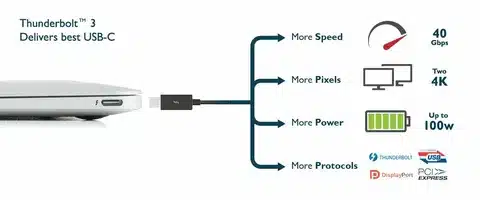
Wattage Considerations
The right wattage is important in order to maximize the charging. With smartphones, 20W chargers are not too big but offer a great level of fast charging c to usb.
Lightweight laptops and tablets work best with 30W to 45 W chargers. These wattages are quick in charging the medium sized batteries besides being small and cheap usb pd.
Powerful laptops need 65W or 100 W hard disks. Such high power chargers can work with high load devices and be smaller than conventional laptop power adapters micro usb.
Port Configuration
Single-port chargers are well suited to people who charge only one device at once. They tend to be the smaller and the cheapest.
Multi-port chargers are ideal when the user has more than one device. A 3-port charger is a 65W charger capable of charging a laptop, a smartphone, and a tablet at the same time, and which intelligently allocates power to each of the devices depending on their requirements.
Take into account your charging pattern and select port configuration. Multi-port chargers are very convenient and valuable in case you travel a lot or have many devices.
GaN Technology
The most recent technology in charger design is the Gallium Nitride (GaN). The use of GaN chargers is much smaller and efficient compared to the conventional silicon-based chargers.
And a 65W GaN charger can be 4050 percent smaller than a comparable traditional charger and produce less heat and use less energy.
Another aspect of GaN technology is that it can support greater power density, which means manufacturers can develop inconceivably small high-wattage chargers that were not possible in earlier manufacturers.
Top USB-C Power Delivery Chargers
BOOST↑CHARGE™ 20W USB-C Charger
The size of this compact charger makes it ideal to smartphone users that desire high-speed charging without being bloated. It can charge up contemporary smart phones to 50 percent in 30 minutes only.
The 20W delivery is the perfect option to use with iPhone 15/16 series and majority of android smartphones. It is small in size and therefore ideal in travel or desk use.
The presence of safety certifications guarantees high reliability of operation and the durability of the construction implies that it can be used over a number of years.
BOOST↑CHARGE™ 30W USB-C Charger
Incorporating a state-of-the-art GaN technology, this charger is 30W packing and has a truly minuscule size. It is ideal on tablets and light laptops.
The effective design implies fewer heat emissions and the increased duration of able to use the charger. Though it is compact, it provides regular, consistent power to your appliances.
This charger is the one that has the ideal combination of power, size, and efficiency to the needs of most users.
BOOST↑CHARGE™ 3-Port 65W GaN Charger
This is a multi-port powerhouse that can be able to charge three devices simultaneously with smart power distribution. The total output of 65W is ideal since laptop users require to charge their phone and accessories.
GaN technology maintains the size of the charger small despite its high power output. Algorithms of smart charging guarantee optimal power to each device connected.
Port configuration usually consists of two USB-C PD ports, and one USB-A port, to support as wide a range of devices and cables as possible.
BOOST↑CHARGE™ 20K Power Bank
This power bank has a high capacity and USB-C PD fast charging, making it the solution to portable charging. The 20,000mAh battery functions to charge most smartphones 4-5 times.
USB-C PD and USB-A ports are both flexible in charging a variety of devices. Its smaller size ensures that it is ideal in traveling or outdoor functions.
Fast charging capabilities imply that you can replenish the power bank itself as well as the devices that are connected to it very fast.
Tips for Maximizing Charging Efficiency
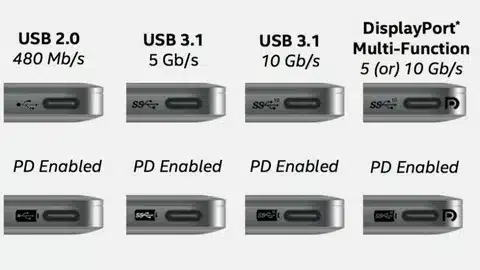
Use Certified Cables
The charger is not the only essential one; the cable you use is very important. Not all non-certified cables, like the lightning cable, support the full USB-C PD speeds, so you can be restricted in charging.
Seem to look after cables that have the USB-IF qualification or are rated explicitly to USB-C PD. These cables will be able to achieve more power levels without any danger.
Not only cheap cables might charge slowly but they may actually break your devices. Your electronic valuables are safeguarded by investing in quality certified cables.
Avoid Overcharging
Modern devices have a protection in place to guard against being overcharged, but unplugging devices after 100 percent charge is best practice.
Overcharging that is always done may decrease the life of the battery in the long run. A majority of the devices are intelligent enough to cease charging at 100 percent, and leaving them plugged in might create heat that is not necessary.
Think of employing smart plugs or timers in order to automatically switch off after some time.
Keep Firmware Updated
Firmware updates are periodically issued by device manufacturers that have the potential to enhance the efficacy and safety of charging. Ensure that you update your devices in order to enjoy these improvements.
New firmware can contain superior power management, charge algorithms, or greater safety.
These updates are commonly automatic, yet it is possible to manually check them in case you realize that there are modifications in charging performance.
The Future of USB-C Power Delivery
Adoption Across Devices
The uptake of USB-C PD is still rapidly increasing in all areas of devices. Even manufacturers that are traditionally proprietary are adopting this universal standard.
USB-C charging ports are to become the new global standard of charging devices, and the mandate of USB-C charging ports assigned by the European Union will strengthen the adoption rate.
USB-C PD can be anticipated to be used in still further types of devices; both gaming controllers and smart home devices.
Integration with USB4 and Thunderbolt
USB-C PD in combination with USB4 and Thunderhead technologies will produce even more powerful and versatile connections.
Such cutting-edge requirements will allow the high-speed data transfer and rapid charging to be implemented simultaneously by using the same cable, which can make our digital life even easier.
The implementation in the future can also enable even greater levels of power, as possibly 240W when needed by the most challenging devices.
Sustainability Efforts
The driving force towards standardization of universal charging is environmentally friendly. Less electronic waste corresponds to fewer proprietary chargers.
USB-C PD chargers are also improved in efficiency, resulting in lower energy usage, which also works to lower environmental impact.
Recycled material and sustainable USB-C PD charger packaging manufacturers are gaining momentum.
Stay Ahead with USB-C Power Delivery
USB-C Power Delivery has transformed our thinking in the way we charge our devices. The speed of charging for all your devices , the universal character, and compactness make it the absolute winner of the charging technology race.
Whether it is by replacing older charging standards or seeking to rationalise your existing installation, USB-C PD has some real advantages that you would feel daily.
The move away from the Lightning port to USB-C is almost complete, and even Apple is now taking the benefits of USB-C. The iPhone USB-C move is the last significant move towards universal fast charging.
USB-C PD will keep on evolving as we move into the future and it will have even faster charging rates and connect even more devices. USB-C PD is an investment option today because, with it, you invest in a technology that you will make good use of in the following years.
It is not a question of whether USB-C charges quicker – it is only about whether you can afford to continue using slower-d charging solutions. Switch to USB-C Power Delivery and enjoy the benefit of being able to charge anything really fast and everywhere.





